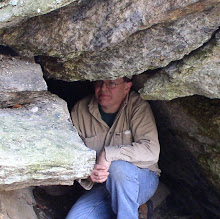
Some good presented itself as I was about to begin another vacation. It appeared I might be able to get my 'travel boat' back on the water again. So this spoke loud and clear about returning to coastal areas. I decided to put part of a day trying to pick up where I left off in Newport, Rhode Island.
But it was not meant to be as upon my arrival the area was shrouded in fog and the seas - just VERY choppy. So after a morning of casual sight seeing, I rolled on up to the area of Fall River for further investigations into Rocky Woods where old King Philip (aka: Metacom) once use to roam.
The second day brought me out to the South Shore coast of Massachusetts, an area I have spent much time over the years. Wanting to keep things on the 'light' side I proceeded to work a series of old leads and sites. First stop was the Cleft Rock near Manomet. Many years since I saw this intriguing split rock formation.
Rolling up the coast I continued on with the investigation of a Devil's Rock. This town reportedly had at least a couple, along with a couple more rocky formations named for old Satan. I'm not altogether convinced this rock that I got a second look at is the real deal. Some scratches (probably glacial) but I don't see 'footprints'. However, it is impossible to tell how much imagination the local people in Colonial times used in seeing these phenomena. But it seems I'm getting closer, as the the rock written of in local history, was in - or near - an old brickyard. There are old bricks here and a hand-drawn map found a couple years back, marks the brickyard as very close by. Likely coming in by river may be necessary.

Library visits were made intermittently as a bit of relief from the scorching heat. After once such stop, I continued my trek up the coast dropping in again on another King Philip's site. This was also to check a legitimate access route across conservation land where previously I had to ask (but much shorter) to cross neighboring territory. One note: this particular King Philip's Rock has one reference to being Pulpit Rock.
Still farther up the coast: low tide, The Nubian Head Rock, a library, and some reconnaissance to see if some type of access might be had to another Cleft Rock written up in local history. Although I have repeatedly tried this many times over the years, the feeling is of being completely stymied. What would have been perfect access, was an old railroad bed. However, recent years has seen that railroad reactivated. The rest of the area is covered with residential neighborhoods and swampy meadows.
The same can mostly be said of nearby Sunset Rock. Once the place to obtain beautiful views, It now has the same railroad line below it, and residential backyards bordering its opposite side.

On the third day, I sat sipping MickeyD's coffee while waiting out some foul weather that had moved in the previous night. Eventually I took to the coast examining a number of rocky sites but also with an eye towards some possible water access routes. I came on in by Kent Rocks, but soon found access to a local river a bit inland where finally I could pull out the kayak. Sailing the lowering tide towards the ocean, I passed a number of fine rock outcroppings. One towering monolith was later identified as Buck Rock. On the return, a trip down a side inlet brought me to Landing Rock where baptisms once took place during the 1800's.

The fourth - and final day - was planned to be a light one. Having secured knowledge of a kayak access point from a local individual, I set out for the Indian Well, Indian Pot, and other glacial potholes. Although these are suppose to be along the shoreline - they never were seen.


